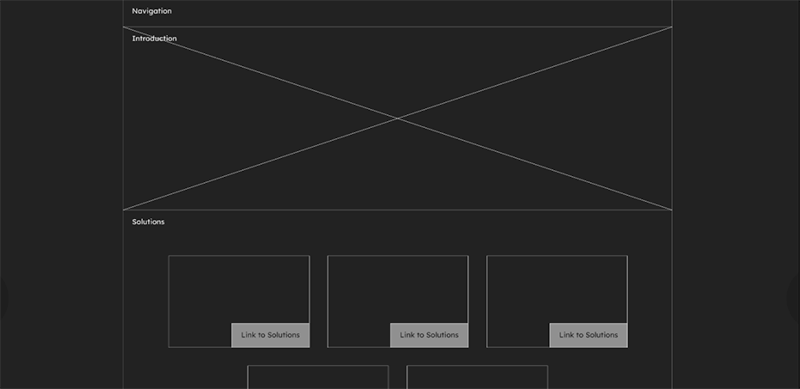
Tools to Strategize Website UX for SaaS Marketing

You have been given the helm on your SaaS company’s marketing website project. Ready, set, go!
Right off the bat, the task may feel overwhelming. This is the main hub of lead/sales generation, so there will be a lot of important decisions to make as you move ahead. There are thousands of assets (e.i. images, videos, copy, and animations) that need to be organized and collected from dozens of sources, and each asset needs to have a designated space based on the company’s goals and the users’ needs. It can be hard to know where to begin and what the overall structure of the site should look like.
Before diving into the asset collection process though, what you really need is a user experience plan. A strategy that dictates how the site will flow from the user’s entry to their exit.
User Experience (UX), as defined by the Nielsen Normon Group, “encompasses all aspects of the end-user’s interaction with the company, its services, and its products.” We know—it sounds daunting. How it applies to conceptualizing a SaaS marketing website is far simpler: UX is the website’s interactive structure used to align the company’s goals with the user’s needs. To begin the UX planning, start with the user. Understand the user’s intent and outline the value they will receive by coming to your site.
Defining the User Value of Your SaaS Marketing Website
When SaaS companies approach us for a website design project, they understand their site is the centerpiece to all of their marketing initiatives, and a lot of their future success as a team is dependent on the website. The website’s ROI needed to be justified and the site’s results needed to align with the company’s growth goals for them to have gotten to the website design scoping phase in the first place. However, rarely, has the same strategic thought been put into articulating the benefits users will receive from engaging with their marketing site. UX Strategy allows you to take your company’s product/profit driven mindset and align it with the objectives and needs of your potential user.
Start by asking yourself the following questions:

- Who are your users? Why will they be on this website? What are their circumstances?
- What business goals will they accomplish by using your SaaS platform?
- What are the main selling points of your SaaS? What sets you apart from competitors?
- What tools will you need to convey this value to the user? (e.g., testimonials, case studies, how-to guides, demos)
- How will you track that this value is being effectively conveyed? (e.g., site KPIs)
Conduct user research, interview potential users, review past web analytics, establish/solidify their needs, and build a brief for your SaaS Marketing site’s UX. Use this research to create a UX Brief document that can be a team tool as you move into the site structure portion of the planning phase. Make sure all stakeholders on your team have viewed and provided feedback on this document. It will keep everyone in alignment with the overall rationale for this project and will ensure that the user is served with a cohesive value statement throughout their entire site experience.
The next step after user research and value conceptualization is laying out the user’s journey through the site, from entry to exit.
Laying Out the User Journey of Your Website
Utilizing the user research and scenarios outlined in the UX Brief document, there should be clear user needs that your SaaS company works to satisfy. These user needs will drive the website page layouts and its overall structure. The best way to visualize a site architecture is to create a sitemap (click for example) that starts with the homepage and indicates all the other primary pages or collections of pages the user will need to interact with. Once the site navigation is solidified, spend time creating content requirements for each page identified. These requirements will loosely outline how value will be conveyed on each page from user entry to exit. The content requirements are crucial for wireframing (outlining visually) the flow of content on each page. Click here to view an example content requirements document and click here to view an example wireframe.

Use this phase of the planning process to ask yourself the following questions:
- What information do you want them to take away from the entire interaction? What information do you want to capture before they leave?
- What pages are the most important for all users to view? Which are only important to a niche audience?
- What header navigation language simply conveys the value users will find from the pages in that section?
- How can every page/post have an engaging call-to-action that aligns with user needs and company goals?
This process of sitemap, content requirements, and wireframe creation will help direct the asset collection process ( e.i. images, videos, copy, animations) and will provide a dependable skeleton to refer back to as you move into the final UX planning phase of page value statement creation.
Creating Page Intro Statements for Your Website
Often, companies get mired in the jargon they use to communicate internally every day, and begin to transfer that jargon to their marketing tools. The issue being users that come to the website are often in the research/discovery phase and internal jargon will go right over their head. In order to streamline value messaging on each page, a client-oriented page intro should be crafted. Building on the content requirements, a page intro statement helps to quickly and effectively convey a page’s purpose/value proposition to a user. It can, also, be used as a guiding light for the page copy creation process.
Avoid jargon by asking yourself these questions while creating page intros:
- What messaging makes the most sense to your users, based on their needs?
- What circumstances brought them to this page?
- What solution is being provided? What is in it for the user?
- What information is going to be conveyed on this page?
Create a spreadsheet with each page next to its specific page intro statement (Click here to view example). Once you have your page intros spreadsheet (along with the other tools discussed), you are ready to move into the website design and UI (user interface) stages of the project with a clear strategic direction that aligns with user needs.
Taking Charge of Your SaaS Marketing Website Project
We know. It’s a lot, but this planning phase is the most important stage of any website design project. Take the time to conceptualize, outline, and simplify now, so there is not content scrambling later down the road. Use these UX tools to ensure the end result will deliver a user-centric website that is focused on your customers’ needs, in addition to meeting your SaaS company’s future business objectives.
All UX Tools examples: